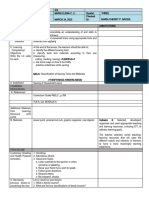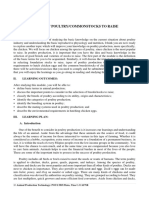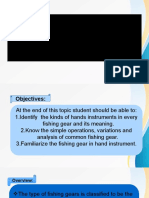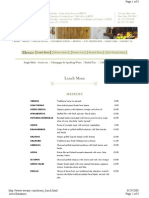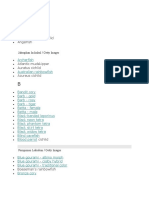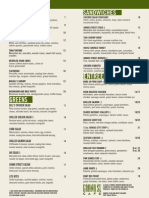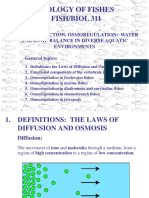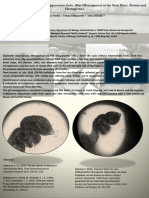100%(1)100% found this document useful (1 vote)
147 viewsAquaculture Lecture 1 Final
Aquaculture Lecture 1 Final
Uploaded by
Kristine Hinayon CarpioThe document discusses three main topics:
1. The three branches of fishery arts: fish culture, fish capture, and fish preservation.
2. An overview of aquaculture, including different culture systems (open, semi-closed, closed), environments (freshwater, brackish, marine), and phases (seed production and grow-out).
3. The purposes and benefits of aquaculture, such as food production, economic growth, and using aquatic wastes for other purposes.
Copyright:
© All Rights Reserved
Available Formats
Download as PPTX, PDF, TXT or read online from Scribd
Aquaculture Lecture 1 Final
Aquaculture Lecture 1 Final
Uploaded by
Kristine Hinayon Carpio100%(1)100% found this document useful (1 vote)
147 views49 pagesThe document discusses three main topics:
1. The three branches of fishery arts: fish culture, fish capture, and fish preservation.
2. An overview of aquaculture, including different culture systems (open, semi-closed, closed), environments (freshwater, brackish, marine), and phases (seed production and grow-out).
3. The purposes and benefits of aquaculture, such as food production, economic growth, and using aquatic wastes for other purposes.
Copyright
© © All Rights Reserved
Available Formats
PPTX, PDF, TXT or read online from Scribd
Share this document
Did you find this document useful?
Is this content inappropriate?
The document discusses three main topics:
1. The three branches of fishery arts: fish culture, fish capture, and fish preservation.
2. An overview of aquaculture, including different culture systems (open, semi-closed, closed), environments (freshwater, brackish, marine), and phases (seed production and grow-out).
3. The purposes and benefits of aquaculture, such as food production, economic growth, and using aquatic wastes for other purposes.
Copyright:
© All Rights Reserved
Available Formats
Download as PPTX, PDF, TXT or read online from Scribd
Download as pptx, pdf, or txt
100%(1)100% found this document useful (1 vote)
147 views49 pagesAquaculture Lecture 1 Final
Aquaculture Lecture 1 Final
Uploaded by
Kristine Hinayon CarpioThe document discusses three main topics:
1. The three branches of fishery arts: fish culture, fish capture, and fish preservation.
2. An overview of aquaculture, including different culture systems (open, semi-closed, closed), environments (freshwater, brackish, marine), and phases (seed production and grow-out).
3. The purposes and benefits of aquaculture, such as food production, economic growth, and using aquatic wastes for other purposes.
Copyright:
© All Rights Reserved
Available Formats
Download as PPTX, PDF, TXT or read online from Scribd
Download as pptx, pdf, or txt
You are on page 1of 49
Branches of Fishery Arts
Fish Culture
Fish Capture
Fish Preservation
UEP, COEd-BTLEd Dept.
Fish Culture or Aquaculture - it is the science of
raising aquatic products under a controlled or semi-
controlled environment.
Fish Capture - It is the branch of fishery science
that deals with the scientific method of catching
any auatic animal, using any kind of fishing
methods, often operated from a vessel.
Fish Preservation- it is the method of extensing the
shelf life of fish and other fishery products by
applying the principles of chemistry, engineering,
and other branches of science in order to improve
the quality of the products.
UEP, COEd-BTLEd Dept.
AFA 4a (Aquaculture)
Credit : 3 Units
LINA B. PEPITO, LPT, MS BioSc
Special Lecturer
UEP, COEd-BTLEd Dept.
Course Description:
This course aims to provide the
learners with an overview of
aquaculture. It includes water
quality, production system, spawning
and the common fish cultured in the
community.
UEP, COEd-BTLEd Dept.
Overview of Aquaculture
In recent years, attention has been focused on
addressing the global challenges of hunger,
malnutrition and impaired health in our population.
Since 2014, aquaculture has provided more fish for
human consumption that capture fisheries, and by
2020 it is expected to contribute 60% o the total fish
and shrimp available for human consumption.
Expanding the role of aquaculture towards ending
hunger and all forms of malnutrition is an important as
to focus on increasing production.
UEP, COEd-BTLEd Dept. UEP, COEd-BTLEd Dept.
Overview of Aquaculture
Aquaculture is the fastest growing food supply sector
in the world and it helps us with food security.
UEP, COEd-BTLEd Dept. UEP, COEd-BTLEd Dept.
Overview of Aquaculture
Aquaculture is uniquely positioned to be one of the
driving forces needed to address the nutrition
challenges that we face in the world today.
(dsm.com.news)
Aquaculture is the fastest growing food supply sector
in the world and it helps us with food security.
UEP, COEd-BTLEd Dept. UEP, COEd-BTLEd Dept.
Principles of Aquaculture
Aquaculture
denote all forms of culture of aquatic animals
and plants in fresh, brackish and marine
environments. (Pillay and Kutty, 2005).
refers to fishery operations involving all forms of
raising and culturing fish and other fishery
species in fresh, brackish, and marine areas
(RA 8550: Fisheries code of the Philippines).
UEP, COEd-BTLEd Dept.
Principles of Aquaculture
Aquaculture
The rearing of aquatic organisms under
controlled or semi-controlled conditions.
Underwater agriculture or water farming
A science and an art.
(Stickney, 1994)
UEP, COEd-BTLEd Dept.
Principles of Aquaculture
Aquaculture
practice of rearing, growing or producing
products in water or in managed systems
(Meade, 1989).
encompasses freahwater, brackishwater and
saltwater.
UEP, COEd-BTLEd Dept.
Principles of Aquaculture
Aquaculture
A term describes a variety of management
procedures designed to increase production of
living aquatic resources beyond that which is
normally available from harvesting wild stocks.
UEP, COEd-BTLEd Dept.
Aquaculture Methods and Practices
A number of aquaculture practices are used world-wide in different
types of environment for a great variety of culture organisms.
Three types of environment where aquaculture is done:
Freshwater - freshwater aquaculture is carried out either in
fishponds, fish pens, fish cages, or on rice paddies
Brackish Water - done mainly in fish ponds located in coastal
areas
Marine water - employs either in fish cages or substrates for
molluscs and seaweeds such stakes, ropes, and rafts
UEP, COEd-BTLEd Dept.
Overview of Aquaculture
Basic categories of culture systems :
Open culture systems
Semi-closed systems
Closed systems
UEP, COEd-BTLEd Dept.
Overview of Aquaculture
Open culture systems - refers to fish farming
in natural bodies of water such oceans, bays,
estuaries, coastal lagoons, lakes or rivers.
examples: cages, pens, enclosures, raft,
long lines
UEP, COEd-BTLEd Dept.
Overview of Aquaculture
Cages vs Pens
Both terms are often used interchangeably
also called generally as enclosure culture, involving holding of
organisms captive in an enclosed space while maintaining free
exchange off water.
Cage - totally enclosed on all, or all except the top, sides by
mesh or netting (maybe floating or fixed)
Pen - bottom of enclosure is formed by lake or sea bottom
(only sides are enclosed with nets)
UEP, COEd-BTLEd Dept.
Fish Pen Cages
UEP, COEd-BTLEd Dept.
Raft culture of mussel
UEP, COEd-BTLEd Dept.
Overview of Aquaculture
Mariculture - or marine farming is a specialized branch
of aquaculture involving the cultivation of marine
organisms for food and other animal products, in
enclosed sections of the open ocean (offshore
mariculture), fish farms built on littoral water (inshore
mariculture), or in artificial tanks, ponds or raceways
which are filled with seawater (onshore mariculture)
Example:
finfish and shellfish like oysters, clams, mussels,
shrimp, salmon and algae.
UEP, COEd-BTLEd Dept.
Overview of Aquaculture
Semi-closed systems
Those in which the culture water makes one
pass through the system and is dischaged.
Also referred as flow-though or once-through
system
examples: ponds, raceways
UEP, COEd-BTLEd Dept.
Pond culture is a very popular aquaculture
production method with many aquatic species
cultured in ponds.
To have successful pond production,
ponds must be properly sites and built,
with careful assessment of water
avilability, quality and quantity.
UEP, COEd-BTLEd Dept.
Overview of Aquaculture
Closed systems
Those in which the culutre water is
reconditioned and reciirculated to the culture
units.
Most recent term is closed-recirculating systems
UEP, COEd-BTLEd Dept.
Aquaponics is a food producton system that
couples aquaculture (raising aquatic animals
sich as fish, crayfish, snails or praws in tanks)
with the hydroponics (cultivating plants in
water) whereby the nutrients-rish aquacultre
water is fed to hydroponically grown plants,
where nitrifying bacteria convert ammonia into
nitrates.
UEP, COEd-BTLEd Dept.
Aquaponics
UEP, COEd-BTLEd Dept.
Integrated multi-trophic Aquaculture (IMTA) -
provides the byproducts, including waste, from the
aquatic species as inputs (fertilizers, food) for
another. farmers combine fed aquaculture (e.g.,
fish, shrimp) with inorganic extractive (e.g. seaweed)
and organic extractive (e.g., shellfish) aquaculture to
create balanced systems for environment
remediation (biomitigation), economic stability
(improved output, lower cost, product diversification
and risk reduction) and social acceptability (better
management practices).
UEP, COEd-BTLEd Dept.
Integrated multi-tropic aquaculture (IMTA)
UEP, COEd-BTLEd Dept.
Overview of Aquaculture
Phases of Aquaculture
Seed production
hatchery
nursery
Grow-out
UEP, COEd-BTLEd Dept.
Aquaculture serves many purposes, including:
Food production for human consumption;
Rebuilding of populations of threatened and endangered
species;
habitat restoration;
wild stock enhancement;
Economic Growth
Foreign Exchange Earnings
Income and Employment
UEP, COEd-BTLEd Dept.
Aquaculture serves many purposes, including:
production of sport fish
culture of bait for commercial or sport fishing
culture of aquatic organisms to supply hobbyist
and scientific research groups and for pets
culture of aquatic organisms as a means of
recycling wastes (biofiltration)
for production of industrial commidities such as oil,
pearls, animal feed and drugs.
UEP, COEd-BTLEd Dept.
Agriculture vs Aquaculture
Agriculture
began 10,000 years ago
the science and art of cultivating the soil,
producing crops and raising livestocks that live on
land.
Limited to land which is only 29% of the earth.
UEP, COEd-BTLEd Dept.
Agriculture vs Aquaculture
Aquaculture
Aquaculture practiced in China, Japan, and
elsewhere in the Far East.
First thesis on aquaculture was published in 475
B.C. by Fan Li.
UEP, COEd-BTLEd Dept.
Agriculture vs Aquaculture
Ancient Greeks and Romans authors refers to
oyster culture and other aquacultural activities.
71% of the earth’s surface is covered with water.
UEP, COEd-BTLEd Dept.
Why is aquaculture lless developed that agriculture?
aquatic organisms live in water (unhospitable and
difficulture to penetrate)
man found it easier to domesticate land animals
fisheries continually replenishing.
Aquaculture is an option to solve food shortage.
Declining fisheries caused the shift from capture
fisheries to aquaculture
UEP, COEd-BTLEd Dept.
From Capture Fisheries to Aquaculture
Declining fisheries caused the shift from capture
fisheries to aquaculture
UEP, COEd-BTLEd Dept.
Important Point !!!
The job of thee aquaculturist is not completed until
the end Market (consumers, patron in a
restaurant, hobbyist, aquaculturists) has received
the product of an aquaculture facilities in
acceptable condition.
UEP, COEd-BTLEd Dept.
An Aquaculturist must be involved in the different activities of aquaculture
Site selection, establishment / construction of culture
facilities
Breeding and Seed Production
Grow-out culture Processing
Marketing
UEP, COEd-BTLEd Dept.
History of Aquaculture
Aquaculture – began 2500 B.C. in China.
Culture of carp called lee under the term of
Emperor Lee
• Fan Li – wrote the first treatise in fish culture
in 500 B.C
• 15th century – Brackish water aquaculture
began in Indonesia with the culture of milkfish
in embanked coastal areas called tambak.
• Oyster farming - Oldest form of coastal
aquaculture 2000 years ago in Japan.
• Seaweed culture in Japan was started in 1952.
UEP, COEd-BTLEd Dept.
History of Aquaculture
• Asia – leader in the field of aquaculture.
• Aquaculture powerhouse.
• Asia produced 89% of the global aquaculture
output in 2020. FAO
Aquaculture sector had the biggest share of
53.7 % in the fisheries production from 2019-
2021.
UEP, COEd-BTLEd Dept.
OVERVIEW OF THE PHILIPPINE FISHERIES
Contribution to World Production
Philippine Fisheries ranked 8th in the world among the leading
fishing countries, with a total annual production of around 4.7 million
metric tons of fishery products including seaweeds (FAO website).
The Philippine aquaculture production of 0.459 million metric tons in
2003 is 11th in the world sharing 1.1% to the total global aquaculture
production of 42.3 million metric tons amounting to about 600 million
dollars in terms of value. (FAO website).
The Philippines is also the world’s 2nd largest producer of aquatic
plants including seaweeds having produced a total of 0.989 million
metric tons or nearly 8% of the total world production of 12 million
metric tons (FAO website).
UEP, COEd-BTLEd Dept.
OVERVIEW OF THE PHILIPPINE FISHERIES
Stimulated by higher global demand for fish, world
fisheries and aquaculture production reached 157
million tons in 2012 and is projected to reach about 172
million tons in 2021, with most of the growth coming
from aquaculture (FAO, 2013).
UEP, COEd-BTLEd Dept.
OVERVIEW OF THE PHILIPPINE FISHERIES
Present status of Aquaculture
Milkfish- the Philippines' national fish, has
carried the country's flag in fishery export, next
to seaweeds.
Pangasinan became the top producer of
milkfish of 45,000 metric tons from 2003 to 2005
or 16.7 percent of the country's total production.
Per capita consumption – 36 kg
UEP, COEd-BTLEd Dept.
OVERVIEW OF THE PHILIPPINE FISHERIES
Milkfish or bangus is a low trophic level
species, is the most important food fish
cultured in the Philippines, Indonesia and
Taiwan as a cheap protein source; its
production in the Philippines
in 2020 was registered at 422.79 thousand
metric tons (PSA, 2020).
UEP, COEd-BTLEd Dept.
Cultured species
The major aquaculture species in the Philippines are:
seaweed (mainly Kappaphycus spp. And Eucheuma spp.);
milkfish (Chanos chanos);
tilapia (mainly Nile tilapia,Oreochromis niloticus);
shrimp (mainly jumbo tiger shrimp,Penaeus monodon);
carp (mainly bighead carp,Aristichthys nobilis);
oyster (slipper-shaped oyster,Crassostrea iredalei); and
mussel (green mussel, Perna viridis).
UEP, COEd-BTLEd Dept.
4 aquaculture commodities:
1. Finfish
2. Crustaceans
3. Mollusks - culture is environmentally beneficial.
4. Seaweeds – consumer of dissolved nutrients and
producers of oxygen
- most environmentally compatible form of aquaculture.
UEP, COEd-BTLEd Dept.
Aquaculture sector
• Total fish production in 2003
aquaculture -17.70%
marine fisheries - 77.23%
inland fisheries 5.07%.
• Main aquaculture species
Seaweed (988 889 t),
milkfish (202 973 t),
tilapia (109 373 t)
jumbo tiger shrimp (34 997 t)
UEP, COEd-BTLEd Dept.
Aquaculture production
seaweed culture - 67.99%
brackishwater fish ponds - 16.84%
freshwater fish ponds - 4.95%
freshwater fish cages - 3.63%
others - 4.12%
UEP, COEd-BTLEd Dept.
Half of the seafood consumed
globally currently comes from
aquaculture, or farmed seafood,
which is increasing at a faster rate
than any other animal production
sector (UNFAO, 2014)
UEP, COEd-BTLEd Dept.
Responsible Aquaculture in the Philippine Context
By Wilfredo G. Yap
Arguments About Aquaculture
➢Destroys the natural environment
➢Blocks the waterways and increases the risks of flooding
➢Keeps out small fishers from the traditional fishing grounds
➢Introduces exotic species to the disadvantage of the native
species
➢Uses and releases harmful chemicals to the detriment of
the natural stock of fish
➢Not an equitable way of using natural resources
Responsible Aquaculture in the Philippine Context
By Wilfredo G. Yap
Responsible Aquaculture
Responsible aquaculture is the farming and husbandry of
aquaticorganisms in a manner which takes into consideration
not only of productivity and profitability but also the physical
and social environment.
Source : Lectures from Prof. Annelie Salvador
UEP, COEd-BTLEd Dept.
Sustainable aquaculture
the management and conservation of the natural
resource base, and the orientation of technological
and institutional change in such a manner as to
ensure the attainment and continued satisfaction of
human needs for present and future generations.
environmentally non-degrading, technically
appropriate, economically viable and socially
acceptable.
Source : Lectures from Prof. Annelie Salvador
UEP, COEd-BTLEd Dept.
You might also like
- Touchstone 4 (2ed) Progress Test Answer KeyDocument6 pagesTouchstone 4 (2ed) Progress Test Answer KeyAlfonso Perez76% (21)
- Tomato in Aeroponics SystemDocument22 pagesTomato in Aeroponics SystemAira Cannille Lalic67% (3)
- Specific Objectives:: Topic Title: The Soups and AppetizersDocument3 pagesSpecific Objectives:: Topic Title: The Soups and AppetizersRuby Esmeralda AndayaNo ratings yet
- CG Epap 311Document3 pagesCG Epap 311Justeen BalcortaNo ratings yet
- Fishery Arts CGDocument4 pagesFishery Arts CGbossigop12360% (10)
- Self Assessment ChecklistDocument67 pagesSelf Assessment ChecklistRutchel MartinezNo ratings yet
- TLE 102 Branches of FisheryDocument37 pagesTLE 102 Branches of FisheryApril Joy Gatilago Abrilla100% (1)
- Module 3-Curriculum Design: 1 Semester 2021-2022 FHRLDocument6 pagesModule 3-Curriculum Design: 1 Semester 2021-2022 FHRLAsuna SanNo ratings yet
- Claud Arthor DoctoBEEd4 Lesson Plan FS2Document10 pagesClaud Arthor DoctoBEEd4 Lesson Plan FS2Geovannie RetiroNo ratings yet
- 2.1tle-8a Branches of Fishery ArtsDocument24 pages2.1tle-8a Branches of Fishery Arts40-Peter Airon SerranoNo ratings yet
- Lesson PlanDocument5 pagesLesson PlanRen Orlandez EamNo ratings yet
- Multigrade Lesson PlanDocument6 pagesMultigrade Lesson Planqw938No ratings yet
- Monitoring Growth and Progress of A FishDocument12 pagesMonitoring Growth and Progress of A FishJONATHAN MERCADONo ratings yet
- Unit 1Document17 pagesUnit 1MERCADO APRIL ANENo ratings yet
- MC TLE 102 Modules (Live Ed)Document92 pagesMC TLE 102 Modules (Live Ed)Charmine MancaoNo ratings yet
- AFA-Chapter 7-Fish Culture-Lesson 1 - DITAN-SAMPAGADocument20 pagesAFA-Chapter 7-Fish Culture-Lesson 1 - DITAN-SAMPAGAReal AnNo ratings yet
- Module For Fish CaptureDocument8 pagesModule For Fish CaptureJerald NoveroNo ratings yet
- TR - Fishing Gear Repair and Maintenance NC IIIDocument56 pagesTR - Fishing Gear Repair and Maintenance NC IIIAldrin TaghapNo ratings yet
- Chap.I Lesson 1Document9 pagesChap.I Lesson 1Eunice Dela Banda ServentoNo ratings yet
- Least Learned Competency Quarter 2Document1 pageLeast Learned Competency Quarter 2Romar SantosNo ratings yet
- Different Methods of Fish ProcessingDocument2 pagesDifferent Methods of Fish ProcessingItachi Paranada100% (1)
- Angeles, Rea P - Unit 1 - Methods in Teaching Industrial ArtsDocument2 pagesAngeles, Rea P - Unit 1 - Methods in Teaching Industrial ArtsEthel Rose SorianoNo ratings yet
- Monday Tuesday Wednesday Thursday Friday: GRADES 1 To 12 Daily Lesson LogDocument4 pagesMonday Tuesday Wednesday Thursday Friday: GRADES 1 To 12 Daily Lesson LogWindy LavarientosNo ratings yet
- Epp WTH Entrep Module2022Document16 pagesEpp WTH Entrep Module2022atz KusainNo ratings yet
- Group 2 Home - EconomicsDocument17 pagesGroup 2 Home - EconomicsRaymart EstavilloNo ratings yet
- CHAPTER-3 EditedDocument28 pagesCHAPTER-3 EditedMichael Pogi RodriguezNo ratings yet
- Syllabus - TQMDocument2 pagesSyllabus - TQMjvanandhNo ratings yet
- AdeyanjuDocument8 pagesAdeyanjuSHRIYA100% (1)
- Tle 1 HandicraftDocument21 pagesTle 1 HandicraftevangelistagerliejoyNo ratings yet
- The Search For Business OpportunitiesDocument15 pagesThe Search For Business OpportunitiesAngelie AnilloNo ratings yet
- K To 12 Basic Education Curriculum Description of FrameworkDocument1 pageK To 12 Basic Education Curriculum Description of FrameworkJonel BarrugaNo ratings yet
- Food Label Lesson PlanDocument8 pagesFood Label Lesson Planapi-394356734No ratings yet
- Rubrics For Vedio Making in Bathroom CleaningDocument1 pageRubrics For Vedio Making in Bathroom CleaningJonalyn Gonzales Gaspar100% (1)
- Chapter 3 - AquacultureDocument40 pagesChapter 3 - AquacultureEvangeline GabrielNo ratings yet
- Agri - Fishery ArtsDocument72 pagesAgri - Fishery ArtsMadelyn ImprosoNo ratings yet
- Q2 - LE - Science 4 - Lesson 5 - Week 5Document17 pagesQ2 - LE - Science 4 - Lesson 5 - Week 5sabasagra02No ratings yet
- Notes For Topic 5 Characteristics of Digital and Non-Digital ResourcesDocument11 pagesNotes For Topic 5 Characteristics of Digital and Non-Digital ResourcesGracelle Mae MaglasangNo ratings yet
- DLL Aqua12 q2 Week2Document5 pagesDLL Aqua12 q2 Week2Joewellyn Lim100% (2)
- MTB-MLE - Mother Tongue Based Multi-Lingual EducationDocument5 pagesMTB-MLE - Mother Tongue Based Multi-Lingual EducationIrishjoy VirayNo ratings yet
- Reflection On The "Analysis and Interpretation and Assessment Results"Document2 pagesReflection On The "Analysis and Interpretation and Assessment Results"Jhemmel Marie A. AquinoNo ratings yet
- Sample Analytic Rubric CookingDocument5 pagesSample Analytic Rubric CookingAiko BacdayanNo ratings yet
- Mariculture: Prepared By: Acel C. PatulotDocument6 pagesMariculture: Prepared By: Acel C. PatulotWella WilliamsNo ratings yet
- Chapter 3 Making Schools InclusiveDocument35 pagesChapter 3 Making Schools InclusiveDemi Deanna PastorNo ratings yet
- The Nature, Goals, and Processes of ScienceDocument1 pageThe Nature, Goals, and Processes of ScienceCharlyn M. CorveraNo ratings yet
- The TLE TVL Framework Overview of SHS TVLDocument57 pagesThe TLE TVL Framework Overview of SHS TVLmark jason100% (1)
- Lesson PlanDocument5 pagesLesson PlanLoraine DocaNo ratings yet
- The Needs of Living Things - Science - Lesson Plan - PBS LearningMediaDocument5 pagesThe Needs of Living Things - Science - Lesson Plan - PBS LearningMediaArnol Ortiz RiveroNo ratings yet
- Curriculum GuideDocument6 pagesCurriculum GuideEdwin LapatNo ratings yet
- Agri Aquaculture For Grades 7 To 10 As of Jan.20.2014Document18 pagesAgri Aquaculture For Grades 7 To 10 As of Jan.20.2014giareysieNo ratings yet
- Edukasyong Pantahanan at Pangkabuhayan: Learning Module (Finals)Document17 pagesEdukasyong Pantahanan at Pangkabuhayan: Learning Module (Finals)Jane Leizl LozanoNo ratings yet
- Farm Inputs PDFDocument16 pagesFarm Inputs PDFColyn AdrianoNo ratings yet
- Cot 1-Daily-Lesson-Plan - Tle 6 Sy2022-'23Document6 pagesCot 1-Daily-Lesson-Plan - Tle 6 Sy2022-'23Maria Elena LiNo ratings yet
- Grade 4 Daily Lesson Plan SCHOOL New Isaela Central Elem. School Grade Level Four TEACHER Analyn S. Albento Quarter Subject Date Week I / 8:50 - 9:40Document12 pagesGrade 4 Daily Lesson Plan SCHOOL New Isaela Central Elem. School Grade Level Four TEACHER Analyn S. Albento Quarter Subject Date Week I / 8:50 - 9:40John Andrie Sumatra AlbentoNo ratings yet
- What Is TLE and Its ImportanceDocument7 pagesWhat Is TLE and Its ImportanceRufina ConstantinoNo ratings yet
- Most Essential Learning Competencies (Melc) : Resource Speaker: Renan L. MarigosioDocument33 pagesMost Essential Learning Competencies (Melc) : Resource Speaker: Renan L. MarigosioLady Paul SyNo ratings yet
- DAILY LESSON Plan 4 - 1.8Document4 pagesDAILY LESSON Plan 4 - 1.8Wilbeth PanganibanNo ratings yet
- DLL - Science 4 - Q2 - W4Document9 pagesDLL - Science 4 - Q2 - W4FredjayEdillonSalocotNo ratings yet
- Lesson Plan - Indigenous Materials MircoteachingDocument8 pagesLesson Plan - Indigenous Materials Mircoteachingapi-441238919No ratings yet
- Animal ProductionDocument35 pagesAnimal ProductionIsheemae Indaya PaloyoNo ratings yet
- OBE Syllabus in EPP With EntrepDocument5 pagesOBE Syllabus in EPP With EntrepZaira Mae BanghonNo ratings yet
- Lesson 3: Mensuration and Calulation: Measuring Tools and Trade MathematicsDocument12 pagesLesson 3: Mensuration and Calulation: Measuring Tools and Trade MathematicsIvy ManasNo ratings yet
- Fishery PresentationDocument50 pagesFishery Presentationtemesgenamare267No ratings yet
- Aquaculture Reviewer (2ND Sem)Document7 pagesAquaculture Reviewer (2ND Sem)Gem Raven Allado ManolidNo ratings yet
- Ponds Design and ConstructionDocument93 pagesPonds Design and ConstructionKristine Hinayon CarpioNo ratings yet
- (Aquaculture) Monitoring of Soil and Water QualityDocument33 pages(Aquaculture) Monitoring of Soil and Water QualityKristine Hinayon CarpioNo ratings yet
- Module 3. Breeds of PoultryDocument8 pagesModule 3. Breeds of PoultryKristine Hinayon CarpioNo ratings yet
- Module 4. Animal NutritionDocument8 pagesModule 4. Animal NutritionKristine Hinayon CarpioNo ratings yet
- (Fish Capture) Hand Instrument and Its VariationDocument24 pages(Fish Capture) Hand Instrument and Its VariationKristine Hinayon CarpioNo ratings yet
- (Aquaculture) Water Quality Management in AquacultureDocument24 pages(Aquaculture) Water Quality Management in AquacultureKristine Hinayon Carpio100% (1)
- SURF FISHING For BeginnersDocument7 pagesSURF FISHING For BeginnersharryumolyNo ratings yet
- OGR Part 1Document18 pagesOGR Part 1DanielleNo ratings yet
- Battle On The Bay - Tournament RulesDocument3 pagesBattle On The Bay - Tournament Rulesapi-232434183No ratings yet
- Old Man Comprehension QuestionsDocument3 pagesOld Man Comprehension QuestionsAlyssandra SloopNo ratings yet
- Strategies For Enhancemnt in Food Prodn PowerNotes by KT SirDocument2 pagesStrategies For Enhancemnt in Food Prodn PowerNotes by KT SirAnupam KumarNo ratings yet
- DD EditedDocument26 pagesDD EditedVighneshNo ratings yet
- Notice: Grants and Cooperative Agreements Availability, Etc.: Monkfish Research Set-Aside ProgramDocument4 pagesNotice: Grants and Cooperative Agreements Availability, Etc.: Monkfish Research Set-Aside ProgramJustia.comNo ratings yet
- Avra LunchDocument4 pagesAvra LuncheatlocalmenusNo ratings yet
- Seafood Value Chain RevenueDocument51 pagesSeafood Value Chain RevenuebiggiantNo ratings yet
- Project 2Document3 pagesProject 2api-253716121No ratings yet
- Module 4 Non Fish Aquatic ResourcesDocument30 pagesModule 4 Non Fish Aquatic ResourcesErine Contrano100% (1)
- Cage Pangasius FullDocument12 pagesCage Pangasius FullMirela CrețuNo ratings yet
- Answers Are at The Bottom of The Page.Document3 pagesAnswers Are at The Bottom of The Page.mohanaaprkashNo ratings yet
- Managing Enterocytozoon Hepatopenaei (EHP), Microsporidial Infections in Vannamei Shrimp Farming: An AdvisoryDocument6 pagesManaging Enterocytozoon Hepatopenaei (EHP), Microsporidial Infections in Vannamei Shrimp Farming: An AdvisorySuresh GodavarthiNo ratings yet
- Fishes ListDocument8 pagesFishes Listshikeb aliNo ratings yet
- Fishery Product Market Survey Consolidated Report ITC NUBB RUA 20220314Document56 pagesFishery Product Market Survey Consolidated Report ITC NUBB RUA 20220314Chhe SovannarithNo ratings yet
- History of The Offshore Oil & Gas Industry in Southern Louisiana - Vol 5Document1,266 pagesHistory of The Offshore Oil & Gas Industry in Southern Louisiana - Vol 5Faiz AhmadNo ratings yet
- Thesis 1997 Zakaria PDFDocument230 pagesThesis 1997 Zakaria PDFmanu5484545No ratings yet
- Q2 Cookery 10. Storing Fish and Shell FishDocument24 pagesQ2 Cookery 10. Storing Fish and Shell FishRonamel NavarroNo ratings yet
- Grand Street MenuDocument1 pageGrand Street Menusupport_local_flavorNo ratings yet
- 014-Osmoregulation (1) Biology of FishesDocument39 pages014-Osmoregulation (1) Biology of FishesIyunkz ScremoemotionNo ratings yet
- Protected Areas in The PhilippinesDocument7 pagesProtected Areas in The PhilippinesPaula TobiasNo ratings yet
- FAO-Farm Ponds For Water Fish and AquacultureDocument74 pagesFAO-Farm Ponds For Water Fish and AquacultureCIO-CIO100% (4)
- Capture Fisheries PretestDocument2 pagesCapture Fisheries PretestLucia NarvasaNo ratings yet
- Feasibility Study On The Seaweed Kappaphycus Alvarezii Cultivation Site in Indari Waters ofDocument9 pagesFeasibility Study On The Seaweed Kappaphycus Alvarezii Cultivation Site in Indari Waters ofUsman MadubunNo ratings yet
- First Record of Eudiplozoon Nipponicum Goto, 1891Document1 pageFirst Record of Eudiplozoon Nipponicum Goto, 1891selmabegovicNo ratings yet
- Atlantic Coastwatch: Homeland OffensesDocument8 pagesAtlantic Coastwatch: Homeland OffensesFriends of the Atlantic Coast Watch NewsletNo ratings yet



















































